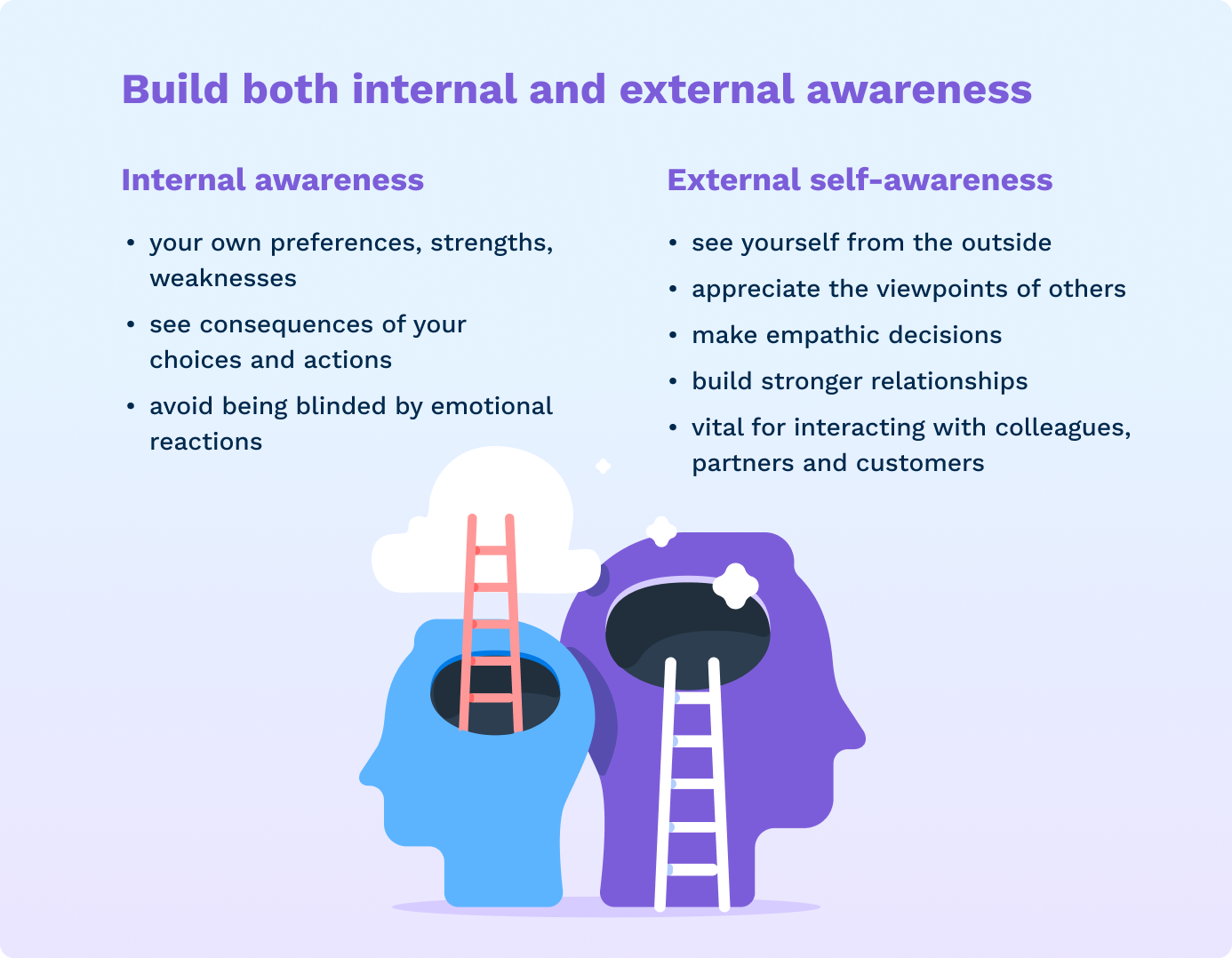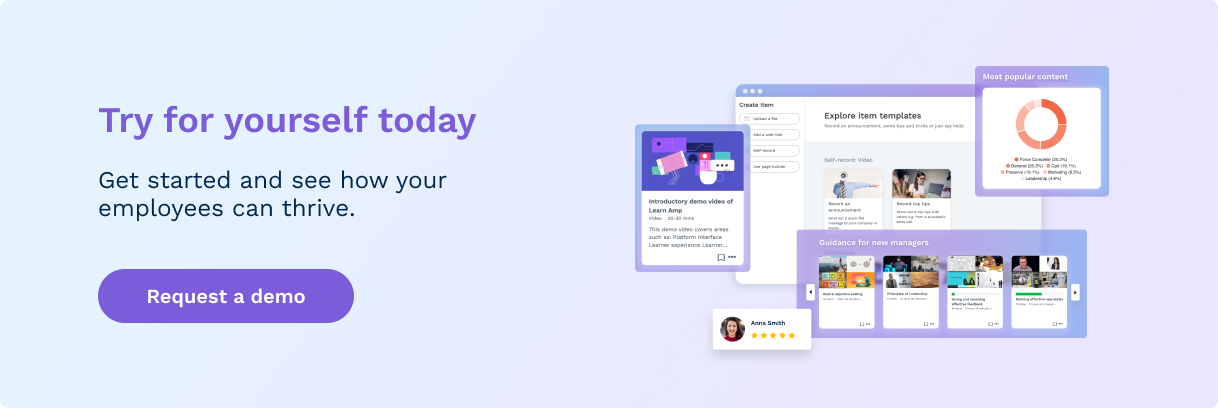
Companies with high levels of self-awareness in their workforces not only offer a great employee experience—they also generate better business outcomes. Learning to be self-aware, then, should be a key part of the employee journey. With the right L&D approach, leaders and employees can develop internal and external awareness, improve learning reflection and self-assessment, and use agile tools to stay goal-focused.
How well do you know your employees? How well do they know themselves? If they rated their own performance, would it align with your assessment of them?
To put it a different way, how would you rate the self-awareness in your business?
It’s an important question. Research shows that companies with high levels of workforce self-awareness achieve better performance outcomes[1]. Self-awareness was found to be the most valued trait in a leader, according to a Stanford Business School survey[2].
Self-awareness in the workplace has the potential to:
- build leadership skills
- improve decision-making
- strengthen team collaboration and communication
- enhance business performance
- improve staff retention
In the world of hybrid and dispersed work, it's not just leaders who need to be self-aware. More than ever, employees need to be independent, autonomous and self-driven enough to control their own performance, development and working relationships.
So how do you promote a culture of self-awareness in your company? Here, we’ll look at three steps you can take, and how they can build a self-aware working culture that works for your bottom line.
What is self-awareness anyway?
According to author Mark Manson, self-awareness is ‘our ability to observe and accurately identify our thoughts, feelings and impulses, and determine whether they are grounded in reality or not.’[3].
A self-aware person can think clearly about their experiences and challenges, and to consciously marshal the appropriate resources to act and react wisely make wise choices about how to act and react. Being self-aware also enables people to be attentive to others, and appreciative of the different talents and experiences they bring to the table.
Self-awareness is at the heart of who we are. It is a trait, a characteristic that some have more than others. But at the same time, it is a skill that can be cultivated and developed.
Here’s how to help do just that in your workplace:
1. Build both internal and external awareness
There are two facets to self-awareness. Internal awareness is the ability to identify and understand your own preferences, strengths, weaknesses. It helps you see and assess the potential consequences of your choices and actions, without being blinded by emotional reactions.
External self-awareness means being able to see yourself from the outside. You are better able to appreciate the viewpoints of others, make empathic decisions and build stronger relationships[4]. External self-awareness is vital for interacting effectively with colleagues, partners and customers[5].

A balance of internal and external self-awareness allows leaders and employees to understand their own performance, while also collaborating and complementing each other for better team and organisational performance.
To develop both internal and external self-awareness in employees, encourage self-rating. Self-assessment lets employees reflect on how they see themselves, while a manager’s assessment shows how others see them. Aligning these two perspectives helps employees develop a more realistic assessment of their own performance.
While self-assessment and prescribed tests have been shown to do produce similar understandings of skill level., That said, self-rating carries the added bonus of boosting self-awareness and self-confidence. Studies with US naval officers have shown that those whose self-rating is in sync with how their subordinates and superiors rate them tend to perform better in their positions[6]. This suggests that trusting your employees to rate themselves while helping them align with the organisational goals will motivate them towards better results.
2. Encourage employees to ask ‘what’ instead of ‘why’
As we’ve seen, self-reflection helps employees assess their performance, recognise their competencies, and identify how they want to develop. However, to be productive, the approach and the questions employees ask themselves need to be the right ones.
The most obvious self-reflection question might seem to be ‘why?’: ‘Why didn’t I make that sale?’ ‘Why didn’t I get that promotion?’ . Questioning the reasons for underperformance might seem a good way to discover what we need to improve, but it can be risky.
Why? Well, when we ask ‘why?’, we're often not really looking for a constructive answer but rather feeling self-pity. ‘Why?’ can easily descend into ‘Why me?’ or ‘Why oh why?’ That’s hardly a productive way to reflect. What’s more, it can lead to negative feelings towards work, which might prod people to start looking elsewhere.
Instead, encourage employees to use ‘what?’ questions in their learning reflection[7]. The question ‘why?’ focuses on the past. What? looks to the future, focuses on objectives and helps us develop and act upon more useful insights. Rather than ‘why didn't I get that promotion?’, ask ‘what prevented me getting that promotion?’ Or better yet, ‘what skills could I develop to help me get that promotion?’.
By adopting a more forward-looking, solution-focused approach to self-reflection and self-assessment, employees can generate greater job satisfaction, ambition and retention.
 |
Download our Skills Summary Download this bitesize summary on how a Skills Framework can drive development. |
3. Treat development conversations as a Retro and Sprint planning
Self-awareness is about where you are now, in the present moment. Being self-aware is just the first step; choosing how to use that awareness to achieve better outcomes is the real objective. This is where applying agile tools and approaches, such as sprint planning, to L&D can really pay off. By setting short, focused tasks and goals, complemented by regular learning reflection, employees and teams can learn, reflect and course-correct, while staying consciously goal-focused.
Bringing these agile approaches into employee development conversations can really enhance self-awareness in employees and teams. An employee who wants to gain a promotion, for example, can reflect on where they are on their career path, and plot out the steps needed to reach their goal. They can identify what skills they need to acquire, the learning they want to undertake and at what level and develop an iterative action plan with interim objectives.
Taking a self-aware sprint-style approach to learning and development, incorporating regular learning reflection and action, can help employees to keep moving towards greater performance and productivity.
Invest in your self-awareness
Businesses of self-aware individuals collaborating in self-aware teams and supported by self-aware leaders are likely to do well. Employees who are fulfilled and satisfied in their jobs will perform better, achieve more, progress further and remain with the company longer[8]. All of which makes for a more profitable company.
Self-awareness makes us more effective workers, leaders and colleagues. Learn Amp’s people development platform provides:
- self-rating and manager rating of skills
- a flexible skills framework, aligned with specific roles
- self-driven learning pathways





